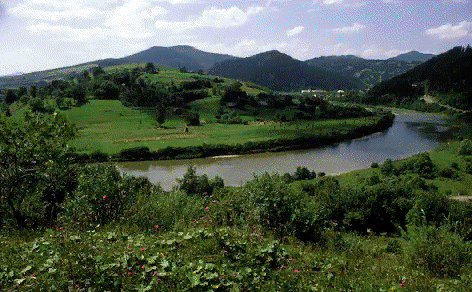

River in the hilly country around Verkhna, south of Lemberg
Galicia becomes part of Austria
After the first division of Poland 1772 the Austrian part is integrated as "Kingdom of Galicia and Lodomeria". Emperor Josef II., who was particularly favorable to this acquisition despite the resistance of his mother empress Maria Theresia, pursued, as he was emperor of the Roman German Reich at the same time, a colonization of the kingdom and recruited colons from Germany.
After riots in the 13 cities of the Zips county, which had been given by Hungary to the crown of Poland in the peace treaty of Lublau 1412, Austrian troops invaded the area - by the way on request of the Polish king - and expanded the occupation to three Polish Starosteis (districts) including the valuable salt mine of Wielicka. The "Kingdom of Galicia and Lodomeria" was named after the old ruthenian principalities of Halicz and Vladimir, the capital was Lemberg, it reached from the eastern borders of Silesia up to the Bug, was polish in the west and ruthenian in the east, it offered particularly good conditions for agriculture. (source: Erich Zöllner, Geschichte Österreichs IV 1970)
Agriculture and Natural resources
In 1835, Galicia was described as extensively rich with good soil; grain, millet, corn, flax, hemp and tobacco were cultivated, also rhubarb around Lemberg. There were herds of large gray cattle, steady horses and bees were bred (source: Austrian Nationalencyklopaedie 1835) It is a hilly country, where oil, natural gas, salt, coal, lead and zinc could be found.
Some pictures of the region can be found at http://www.bialystok.uw.gov.pl/ the site of the Bialystok region.
Immigration of German colons to Galicia
What was the background for the settlement of immigrants? Maria Theresia had lost Silesia to Prussia, with all the Silesian industries (source: Robert Kann, A history of the Habsburg Empire). So why not look for a replacement in agreement with Prussia and Russia? But: the acquisition of Galicia 1772 changed the ethnical equilibrium of the monarchy, the areas north and northeast the Carpathians was also geographically separated from the remainder of the monarchy. The Poles were part of a large and political-culturally independent nation. Maria Theresia and particularly Joseph II. tried to push the Galician economy to the level of the neighboring areas. Immigrants from South Germany were particularly encouraged. They were tax-exempt, their children had no military obligations, they received construction material and agricultural improvements were promoted. The agricultural products could be exported duty-free to Bohemia. All of this in the spirit of enlightenment, which granted new rights to Jews, but particularly looked for efficiency: The emigration was complicated, the immigration facilitated. In Hungary, Transylvania and Galicia German colonies were created as models for the existing population. Jews whose property did not exceed 100 florins were encouraged to leave, they could emigrate without passport. The installation by foreigners of new factories was particularly encouraged. (source: Richard Kralik, Das josefinische Österreich, in “Österreichische Geschichte”, Wien 1914, S. 240)
Glenn Linscheid writes: "Galicia was mainly an agrarian society, underdeveloped, with a poor and uneducated population. Large parts of the property belonged to the church or nobility. The Polish aristocracy considered hunting or other pleasures more important than the development of the country and the population. Galicia was wild and untamed." (source: Glenn Linscheid: "Mennonite Historian" Vol.XXI, NO. 3, September 1995, S 1-2.)
Details to the second immigration wave, to the agriculture and the innovations can be found at www.machmer.de
Radetzkymarsch by Joseph Roth
"The beams of the Habsburg sun reached to the east up to the border of the Russian Czar. Seventeen hours the second lieutenant Trotta sat in the train. In the eighteenth, the last station of the eastern railway of the monarchy emerged. The violets already flowered in the brumous forests. The frogs already croaked in the infinite swamps. The storks already circled over the low straw roofs of the village huts. Swamp-born were the humans of this area. The swamps lay spread over the whole surface of the country, to both sides of the highway, with frogs, fever bacteria and malicious grass, which meant that the innocent hikers were lured into a terrible death. And in the far-away, swamped desert one or the other officer of the garrison fell into despair, gambling, debt and bad company. The cemeteries of the border garrisons held many young bodies of weak men."
Oberst Redl by Heinz Rieder
"The capital Lemberg resembled Vienna. With high blocks of appartment buildings, protruding window decorations, ledges, figures on both sides of the portals and balconies with decorated iron railings. In the main streets rattled the carriages of the farmers, primitively built and dirty, over the cobblestone, the bearded farmers sitting on top on sacks with vegetables and potatoes, skin caps pulled over the ears, the farmer's wives with their multicolored head cloths, jews in their traditional dresses with sheepy buckles, artfully twirled, which nodded too when they nodded to each other. Nearly a third of Lemberg's inhabitants were Jews. A park: no rosebushes, hardly an idea of flowers, some poor bushes. A restaurant: spotted table cloths, covers not clean, dirty napkins, the waiters in spoiled and crumpled tailcoats. The walls were once painted in white, spin weaves in the chandeliers. Outside of the town, fox and rabbit shared company. A short ride by coach and the roads were lost in mud, bordered by straw-covered, poor wooden huts to the left and right, boards put over the groundless puddles, on which one could balance from house to house."
The dream of Josef II. of a rich country did not became true. Numerous inhabitants emigrated to other regions or to America. On the top of the emigration Galicia lost 6,6 % of its population, most in the age group of 20 - 40! In the First World War, the area was a theater of war, afterwards a large part of the population resettled.